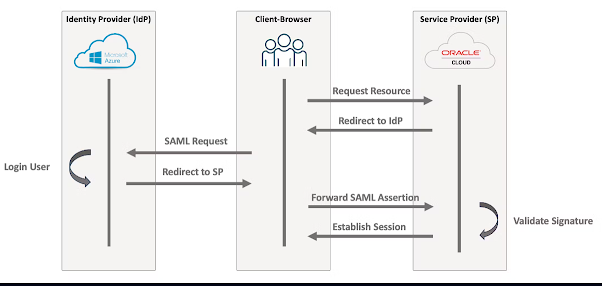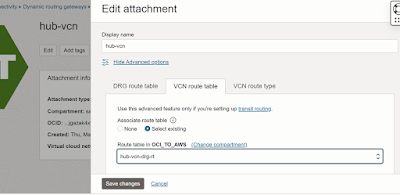Oracle APPS DBA pieces
Blog About Oracle Cloud, Oracle EBS 12.2 upgrade, Database 19c upgrade, cloud solutions, IaaS, PaaS, Cloud, Lift and shift to Oracle Cloud and day to day Oracle Issue... Mostly.
Monday, April 8, 2024
Cross-Platform Efficiency: Mastering Federation of Azure AD with OCI Identity Domains for SSO Solution
Thursday, April 4, 2024
Secure Your Network: Private DNS in Oracle Cloud Infrastructure
Key features and benefits of Private DNS in OCI include:
Custom Domain Names: You can create your own domain names, such as example.com or subdomain.example.com, tailored to your organization's needs.
Resource Mapping: Private DNS allows you to map these custom domain names to specific resources within your VCN, making it easier to manage and access your services.
Network Isolation: By using Private DNS within your VCN, you can ensure that your domain names remain private and are only accessible within your network, enhancing security and control.
Integration with Oracle Services: Private DNS seamlessly integrates with other Oracle Cloud services, enabling you to easily manage domain names for resources such as Compute instances, Load Balancers, and more.
Automation and Scalability: You can automate the creation and management of domain names using OCI's APIs, CLI, or Terraform, making it easy to scale and manage your infrastructure.
Overall, Private DNS in OCI provides a flexible and secure way to manage domain names and map them to resources within your virtual cloud network, facilitating efficient communication and management of your cloud infrastructure.
Now, the objective of this post is to give an idea on how we can communicate to the resources using their hostnames. As we know, DNS is a feature which translates hostnames to IP addresses. If we have resources in OCI and they don't know the respective hostnames, then the communication can't be established. To mitigate this problem, OCI has the option of Private DNS in OCI.
A small use case here.
When we provision a compute instance, it comes with its own fully qualified domain name example oraclevcn.com. Now, if i need to set it to samappsdba.com, we need to perform some additional steps.
The high level steps
Private DNS Zone – which contain DNS data from the VCN (like IP address)
Private DNS Views – this is collection of Zones, Zone can only belong to a single View.
Private DNS Resolver – you can assign Views to Resolver which will then resolve those DNS queries for you. Remember the order, first custom views, then default and finally from Internet
[opc@instance-20240328-1959 ~]$ host -t NS samapspdba.com
samapspdba.com name server vcn-dns.oraclevcn.com.
[opc@instance-20240328-1959 ~]$
After I delete it the private view
@instance-20240328-1959 ~]$ host -t NS samapspdba.com
samapspdba.com name server vcn-dns.oraclevcn.com.
[opc@instance-20240328-1959 ~]$ nslookup www.samapspdba.com
Server:
169.254.169.254
Address:
169.254.169.254#53
** server can't find www.samapspdba.com: REFUSED
This is a basic demonstration on how using private DNS feature in OCI, we can customize the hostname.
I hope this post helps someone.
Tuesday, March 26, 2024
Read only access to OCI Console.
If you need read-only access to the Oracle Cloud Infrastructure (OCI) Console, you can achieve this by creating a policy within OCI Identity and Access Management (IAM) that grants only the necessary read permissions to the resources you want to access. The below steps are applicable to identity domains only. To read more about identity domains identity domains in OCI
Here's a general outline of how you might set this up:
1. Create a User
2. Create a group and assign the above created user to group
3. Create a policy in root compartment
Verb:- allow group group_name to read all-resources in tenancy
Friday, March 22, 2024
Hub and spoke using IP Masquerading in OCI aka Oracle Cloud Infrastructure
Hub VCN: In the hub-and-spoke model, one VCN serves as the central hub where shared services or resources are located. This hub VCN typically hosts core services such as DNS, Active Directory, or shared databases.
Spoke VCNs: Spoke VCNs are additional VCNs that are connected to the hub VCN. Each spoke VCN usually contains resources specific to a particular department, application, or environment.
Dynamic Routing Gateway (DRG): The DRG serves as the central routing hub for connecting the hub VCN to other VCNs or on-premises networks. It facilitates the exchange of routing information between the hub VCN and the spoke VCNs.
DRG Attachments: Each spoke VCN is connected to the hub VCN via a DRG attachment. A DRG attachment establishes a logical link between the spoke VCN and the DRG, enabling traffic to flow between them.
Transit Routing: Transit Routing is a feature in OCI that allows you to route traffic between different VCNs using the hub-and-spoke architecture. With Transit Routing, you can configure route tables in the hub VCN to direct traffic between spoke VCNs through the hub VCN.
Route Tables: Each VCN has its own route table that determines how traffic is routed within the VCN. In the hub-and-spoke model, route tables in the hub VCN are configured to route traffic between spoke VCNs.
Security: Security within the hub-and-spoke architecture is typically managed using Security Lists, Network Security Groups (NSGs), and other OCI security features. Access control can be enforced at the subnet level to restrict traffic between different environments.
By implementing a hub-and-spoke architecture using DRG attachments and Transit Routing in OCI, organizations can achieve centralized network management, simplified connectivity between VCNs, and improved security and compliance. This architecture is well-suited for scenarios where multiple VCNs need to communicate with each other while maintaining isolation and security boundaries.
Now, the objective of this post is to explain, how leveraging DRG attachments and VCN Route tables we can make the communication between hub and spoke. And also, using transit route, how we can enable the resources provisioned inside spoke VCN to reach the internet using Hub VCN.
The security list at this moment has ingress from spoke1 vcn
cidr to spoke2 and vice versa.
I will now try to ping spoke2 instance from spoke1.
As expected, it is not working
next, i am going to attach the 2 spokes
Under DRG, create anew distribution list for hub-vcn attachment
Create a new DRG route table for hub-vcn
Attach the hub-vcn to DRG
Now create a VCN DRG route table and point it to private IP
address of secondary vnic
Add a security list for this public subnet to receive
request from spoke VCNs.
Security list for the spoke VCN. Add a ingress rule to receive request from hub vcn
sysctl -w net.ipv4.ip_forward=1
firewall-cmd --permanent --direct --add-rule ipv4 nat
POSTROUTING 0 \
-o enp0s6 -j MASQUERADE
[root@primary-vnic opc]# firewall-cmd --permanent
--zone public --add-interface enp0s6
The interface is under control of NetworkManager,
setting zone to 'public'.
success
[root@primary-vnic opc]# firewall-cmd --permanent
--zone public --add-masquerade
[root@primary-vnic opc]# systemctl restart
firewalld
[root@primary-vnic opc]# firewall-cmd --reload
success
[root@primary-vnic opc]#
sysctl -w net.ipv4.conf.all.rp_filter=2
added the route for secondary vnic
[root@primary-vnic opc]# ip route
default via 192.168.0.1 dev enp0s6
default via 192.168.0.1 dev enp0s6 proto dhcp src
192.168.0.49 metric 100
169.254.0.0/16 dev enp0s6 scope link
169.254.0.0/16 dev enp0s6 proto dhcp scope link src
192.168.0.49 metric 100
192.168.0.0/26 dev enp0s6 proto kernel scope link
src 192.168.0.49
192.168.0.0/26 dev enp1s0 proto kernel scope link
src 192.168.0.57
192.168.0.0/26 dev enp0s6 proto kernel scope link
src 192.168.0.49 metric 100
[root@primary-vnic opc]# ip route add 10.10.0.0/26
via 192.168.0.1 dev enp1s0
10.10.0.0/26 is the CIDR for spoke1 private subnet
Now, if I try to ping google.com from spoke1 vcn
Through this post, i just wanted to show how using IP Masquerading feature we can reach to the internet from the spoke VCN private subnet. Also, how this can be achieved under Hub & Spoke Model. I hope this post will help someone.
Wednesday, January 17, 2024
connect to Compute instance on Private Subnet using another Compute instance
There are many ways using which we can connect to a compute instance running on private subnet and having only private subnet. We can use OCI Bastion service, Secure shell and for enterprise level, we can leverage FastConnect & IPSecVPN. In my previous post Connect to private compute instance, i have shown, how we can connect to a compute instance running on private subnet using public load balancer. The objective of this post is to show, how we can connect to a compute instance running on private subnet using a compute instance running on public subnet in same VCN. This method is very helpful, wherein if we want to do some POCs and want to connect to private compute instance from our desktop machine locally.
Steps:- I have a VCN named as TEST and inside that i have two subnets one is private and another one is public.
The public subnet has the default security list attached and default route table with Internet gateway enabled. Next, i created two compute instance, one in public subnet and another one in private subnet.
Now, i will connect to the compute instance on public subnet using putty and i will place the public key in rsa format(for private subnet) in some directory



















































